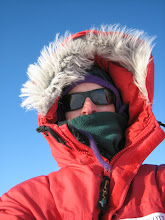You may be interested in what to do in order to go to someplace like McMurdo. Other US Antarctic bases include the South Pole Station (200 people) and Palmer Station (40 people), located on the Antarctica arm pointing towards South America. The process of getting to one of the Antarctic bases starts about 6 months before you go. Raytheon organizes the process and treats it in a very military fashion. The basic steps are:
- Get an invitation. This may be due to a scientific mission that you are part of, as in my case, or a job you get to work in Antarctica. Getting your project approved for Antarctica may take years. Any equipment shipped down has a six month lead time, typically.
- Medical approval – this is by far the most arduous of the tasks. Your doctor must fill out a form as long as both your arms put together, poke and prod you everywhere, and bleed you and ship the blood off to Denver. Then a Raytheon doctor reviews the information and may ask for more, that means back to the doctor, etc. Basically, they want to make sure that you do not have an ailment that could potentially need immediate treatment, since facilities down there are primitive at best, and Christchurch is at least eight hours away, and more realistically days away.
- Travel arrangements – here, Raytheon truly shines. Three weeks before you are scheduled to leave, a representative calls you up and goes over a possible itinerary. After your approval, full price coach tickets are purchased so that they are flexible. My ticket from Cincinnati was about $2200.
- Travel to Christchurch, NZ. Finally, the moment is here! This is done on a common carrier. I flew 12,000 miles on American and Qantas.
- Upon arrival at Christchurch, you are met by a representative of the US polar Programs office. After collecting luggage (not an issue for me since mine was lost) you walk over to the PP office, which is about ¼ mile from the airport terminal. Now it is time to obtain cold weather clothing at the Clothing Distribution Center (CDC) – this is all done in a couple hours right after you get off the plane. You get at least one of each of these items.
- Wait, wait, wait for good enough weather to fly down to McMurdo. I waited for two days. When you finally get to depart, you fly in a military transport plane. (This one is a C130 Hercules owned by the NZ Air Force and had a 7 hour air time to make the Christchurch-McMurdo flight.) The inside is very crowded.
- if going on to the South Pole, wait for the rare flight out of McMurdo that’s going there. It could take a week.
- if going to one of the camps, you must have “Snow School” training so that you don’t die at the first bad weather.
- Start the return process, which means waiting for good weather and a free spot on the plane. Reschedule your return commercial flight (taken care of by Raytheon). I am now scheduled for a Dec 22 return on a C17 Globemaster jet, which only takes five hours. What luxury! Will I really make it that day? Good question. My colleague was scheduled to depart on Saturday. It is now Monday, and he may or may not leave tomorrow. Plane arrivals are subject to weather, and departures are subject to arrivals.

1 comment:
Oh dear. Maybe home for Xmas (do you gain a day by crossing the dateline?)(assuming you do), maybe not, huh? I guess I was assuming that you'd be there longer, actually. If you have trouble getting your experiment off the ground, do you stay longer than scheduled, or is it tough-beans- maybe-next-time?
Post a Comment